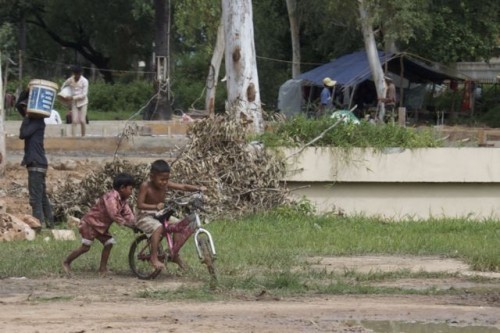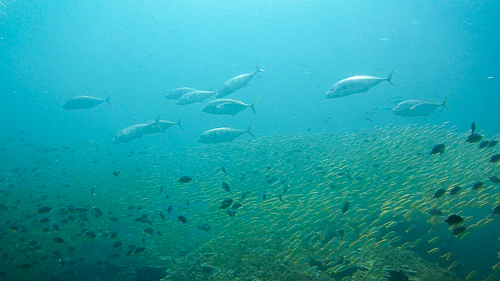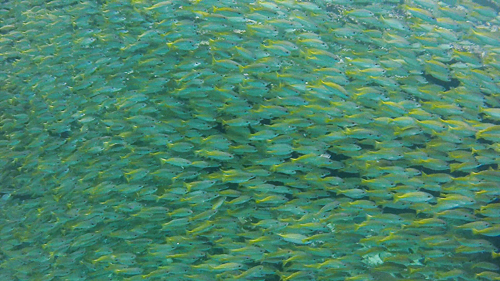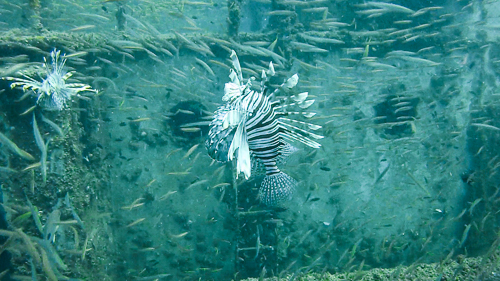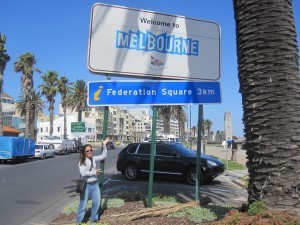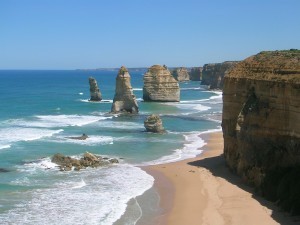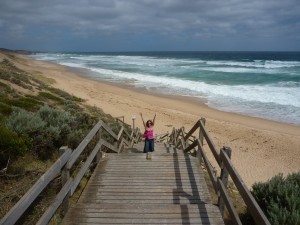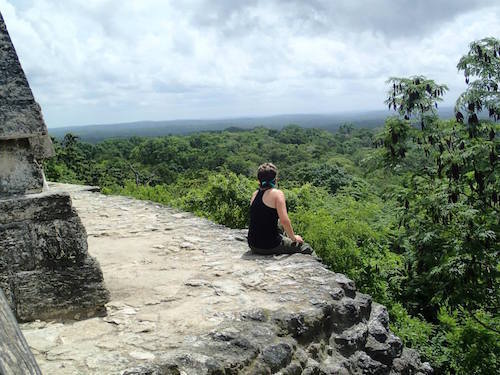Rolf Potts's Blog, page 15
February 20, 2015
Song of the Broken Road- Cambodia
Our Cambodian truck driver, who says his name is “Mr. T,” pulls the Nissan pickup to the side of the road and looks back at me expressionlessly. “You get out!” he says. As if to underscore this suggestion, he steps out of the truck himself, unzips his jeans and begins to urinate on the side of the road.
Since I welcome any chance to exit the jammed mini-cab, I follow suit.
I have been riding in Mr. T’s truck long enough to know that he was not being rude with this curt demand. He was merely showing off his arsenal of English phrases, which also includes “I am Mr. T” and “You pay $6.” Every 20 or so minutes, he turns around and says, “This road very bad, ha-ha!” The quip is meant to be a joke, but after two hours of slamming through the unending succession of potholes and washouts known as Cambodia Route 6, I’m not laughing.
Since Route 6 is the only passable road from the Thai border to the ancient Khmer monuments at Angkor Wat, it gets a surprisingly steady stream of tourist traffic. We are currently at the height of dry season, and the road is as brown and featureless as the Texas panhandle in winter. Each time a truck full of glassy-eyed travelers bounces past, I feel like I’m journeying through some sadistic antipode to Disneyland, where the only ride lasts six hours and is designed to underscore just how long, difficult and boring life can be.
As I void my bladder onto the Route 6 shoulder, I notice that my white-haired seatmate, Mr. Cham, is standing a few paces away, watching me. All dandied-up in a brown porkpie hat and a purple polo shirt, Mr. Cham looks like he’s ready for an afternoon at the horse races. I half expect him to break into applause as I take my whiz. Once I’m finished, he hurries down the road to watch the other foreigner — a middle-aged Belgian named Claude — urinate. I’m beginning to suspect that Mr. Cham doesn’t get out of the house much.
Mr. Cham and I have been smashed up against each other in the Nissan mini-cab all morning. For reasons I don’t completely understand, I am sponsoring his ride. The first time I ever saw him was yesterday. He was wearing a black Bon Jovi T-shirt at the time, and had just stolen my sandals. My second encounter with him was this morning, when he showed up at my departure point from a town known as Opasat and informed my Cambodian hosts that I was to pay for his transit to Siem Reap. It seemed like an odd request at the time, but I went ahead and obliged him out of generic courtesy.
Mr. Cham has no personality and smells like a bag of stale Cool Ranch Doritos. If I had it to do all over again, I would have saved $3 back at the truck depot and made him ride in the back of the Nissan with the old women, the chickens and the bags of rice.
As I return to the truck from my toilet break, Mr. T rushes up to cut me off at the door. At first I think there’s some sort of danger, but it turns out he’s just looking for a chance to show off some more English. “You get in!” he says.
In the waning days of the Jimmy Carter administration, when I was about 8 or 9 years old, I dressed up like Batman and, as part of a UNICEF Halloween promotion, went door to door collecting money for the starving children of Cambodia. As I recall, I was far more interested in Batman than Cambodia, and I only mention it now because it occurs to me that Mr. T (who, despite his authoritative name, is no older than me) was probably one of those starving children.
Perhaps out of gratitude all these years later, Mr. T is hell-bent on driving me to Siem Reap as fast as possible. His road style is bold, unorthodox and unnerving, and I’m beginning to suspect that he originally learned how to drive by watching “The Dukes of Hazzard.”
Claude the Belgian, who shelled out $10 for the shotgun seat, is gripping the dashboard with a queasy, defeated look. The rest of the passengers, including Mr. Cham and me, are packed into the mini-cab so tightly that there’s no point in trying to steady ourselves. With each road flaw, our heads bang back and forth in unison, like we’ve just been teleported here from a Judas Priest concert.
Mr. T slows down only for roadblocks that are manned by men with assault rifles. I have yet to figure out if these armed sentries are soldiers or bandits — or if there is even any distinction between those two job descriptions in northwestern Cambodia. The roadblocks seem to be located only in shaded places where one can hang a hammock, and I suspect that anyone in this country with a spare AK-47 and a little initiative can find part-time work as a freelance Route 6 tollkeeper. Mr. T doesn’t pay the tollkeepers much mind, slowing only to toss a 500-riel note (about $0.13) out the window at each roadblock.
When an old codger on a parched section of the highway tries to wave our truck down with a slingshot and a shoddy bundle of sticks, Mr. T slams on the brakes, jumps out of the truck and chases the old man off into the scrub bushes. I’m not exactly sure what nuances lurk behind this confrontation, but it’s the most excitement we’ve had all day. Everyone cheers when Mr. T gets back into the truck.
The strangest detail about Cambodia Route 6 is that it is populated by so many children. Some of them are out fixing road defects with shovels; others help guide the trucks over dilapidated bridges. All of these kids demand a tip for their services, but Mr. T unconditionally ignores them. Lots of the kids are armed with Super Soaker water guns — probably a holdover from the Khmer New Year’s festivities — and we get ambushed with water whenever we slow down.
Were I a sentimental ironist, I might make some dewy-eyed observation about how these kids represent the peace-loving hopes of post-Pol Pot Cambodia — how these gentle, harmless water guns have replaced the tools of genocide. Unfortunately, I’m not so optimistic. The old ladies and chickens in the bed of the Nissan are completely soaked because of these spiteful little extortionists, and each time Mr. T drives past without tipping them, they shake their fists at him in pre-adolescent fury.
Four hours into our journey, we stop at a village for lunch. “You get out,” Mr. T tells me as we coast to a stop in front of a roadside food stand. I get out.
Since I’m not all that hungry, I stand with Claude the Belgian and stretch my legs. I have stopped trying to talk to Claude because he speaks only French and Khmer. What little English he knows is not much better than Mr. T’s repertoire. I try not to hold this against him, since I studied French for two semesters in college, and all I can remember now is that fromage means cheese.
As Claude and I stand in silence, a Cambodian man across the street takes an AK-47 out from the cab of his truck and starts to fire it into the sky. He is part of a large crowd, and all the women in his immediate vicinity start to scream. Even from across the road, the noise of the weapon gives me a start. The only thing that keeps me from running for cover is Claude, who acts as if nothing is happening.
“What the hell is that all about?” I say under my breath, not really expecting an answer.
“Waiting,” Claude says.
“Waiting for what?” I reply, still under my breath.
“Waiting,” Claude says. “Man, woo-man. Waiting.”
It dawns on me. “Oh, wedding. It’s a wedding party.”
“Oui. Waiting part-ee.”
As I am watching the quirky wedding festivities across the street, I feel a tug on my shirt. It’s Mr. Cham, who indicates that he wants me to come over to the food stand. For a moment, I think Mr. Cham has redeemed himself by ordering me lunch; as it turns out, he just wants me to pay for his lunch. I foot Cham’s lunch bill, secretly formulating ways to dump this creepy little freeloader as soon as I get to Siem Reap.
Since I’m already at the food stand, I decide to check out what kinds of cuisine they offer. The lone on-duty chef at this moment is a scowling 8-year-old girl who chops up a dead chicken with fearsome strokes from a butcher knife. When she finishes, she scoops up the gelatinous cubes of deceased fowl and dumps them onto a plate of rice.
Since the bird was never properly disemboweled, each chicken cube resembles a tidy anatomical cross-section of meat, bones, skin and viscera. In all my international culinary experience, I have never seen the likes of this. I half expect an elementary-school gifted-student coordinator to walk up and cheerily announce, “OK, now let’s see which one of you can put that chicken back together!”
I elect to skip lunch. My quest for a toilet leads me to a forlorn strip of cement behind the food stand, which provides a nice view of Route 6 twisting off into the distance. I wish I could say that the midday sun makes the dusty, brown road seem full of intrigue and possibility, but I’m on the wrong continent for that kind of notion.
In Cambodia, there are no hipster myths or soda advertisements to insinuate that the road is some kind of romantic-individualist icon. In the Cambodian outback, the road is little more than a long, dully dangerous, frequently uncomfortable way to get to Point B from Point A — a monotonous, head-banging waltz-with-misery that you endure in the hope that it will eventually stop, so you can begin to forget about it.
I feel another tug on my shirt. It’s Mr. T, who points back to the Nissan. “You get in!” he says.
I get in. But only because there are no other options out here.
Originally published on Salon.com, May 18, 1999
Original article can be found here: Song of the Broken Road- Cambodia
February 19, 2015
Vagabonding Case Study: Marco Buch
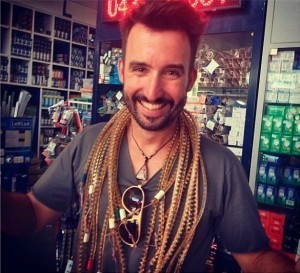
How did you find out about Vagabonding, and how did you find it useful before and during the trip?
I found Vagabonding somewhere along the road and found it to be mainly useful for keeping the travel vibe up and learning how to stay longer.
How long were you on the road?
One year.
Where did you go?
Central America and South East Asia.
What was your job or source of travel funding for this journey?
I worked as a tour guide for a while and had saved from promotion jobs back home.
Did you work or volunteer on the road?
Yes, the tour guide thing. And then I volunteered in Thailand after the Tsunami.
Of all the places you visited, which was your favorite?
I love Thailand by heart. It became a second home for me.
Was there a place that was your least favorite, or most disappointing, or most challenging?
I seriously enjoyed all of it.
Which travel gear proved most useful? Least useful?
A digital camera is a must. But back then I also had a lot of gear that is luckily not needed anymore nowadays.
What are the rewards of the vagabonding lifestyle?
Getting to know locals. Having lots of time to think about oneself. Making friends in fast forward.
What are the challenges and sacrifices of the vagabonding lifestyle?
No chance to hold up a relationship. Insecurity (which is sometimes also a reward, of course)
What lessons did you learn on the road?
So many that I have already written several books and a blog about them!
How did your personal definition of “vagabonding” develop over the course of the trip?
After a while I followed ideas more than itineraries.
If there was one thing you could have told yourself before the trip, what would it be?
Don’t be afraid. It’s all gonna be fine!
Any advice or tips for someone hoping to embark on a similar adventure?
Don’t think too long. Just go!
When and where do you think you’ll take your next long-term journey?
I am leaving every winter. So it should be pretty soon!
Read more about Marco on his blog, Life is a Trip, or follow him on Facebook and Twitter.
Website: Life is a Trip
Twitter: @LifeIsATripCOM
Are you a Vagabonding reader planning, in the middle of, or returning from a journey? Would you like your travel blog or website to be featured on Vagabonding Case Studies? If so, drop us a line at casestudies@vagabonding.net and tell us a little about yourself.
Original article can be found here: Vagabonding Case Study: Marco Buch
February 15, 2015
Travelers risk discomfort for the thrill of a new perspective
“Many travelers seek out this high. We seek out what is different from what we behold in our daily lives, whether it is language, fashion, standards of behavior, architecture, climate, or animal species, because beholding what is different has the quality of being unreal. If our brains resist the realness of something, but this thing is before our eyes, we’re accompanied by little sparks of excitement just by moving through the world. While tourists spend their time away from home seeking our the comforts of home, travelers risk — even cultivate — discomfort, because what they want is the thrill of a new perspective.”
–Alden Jones, The Blind Masseuse: A Traveler’s Memoir from Costa Rica to Cambodia (2013)
(2013)
Original article can be found here: Travelers risk discomfort for the thrill of a new perspective
February 14, 2015
Getting my Open Water in Thailand
Learning to dive was in the front of my mind when I started planning my trip to southeast Asia. Friends had learned in Thailand and I had heard that it was one of the cheapest places to get certified. After some research, we headed towards Koh Tao, an island in the Gulf of Thailand. I was keen to get my Open Water certification, but my husband was not. He agreed to stay on shore and I signed up for the three day course.
My brain was stretched and challenged as I did my homework each night; I enjoyed learning new terms and pondering the science involved in taking a human body deep underwater. I was back in school and excited to learn about decompression sickness and the volume of the air in my lungs under pressure. Over those three days, I learned the skills I needed to stay alive and also realized a recurring dream I have of being able to breathe underwater. I made new friends and relied on them for my safety. Diving began to feel natural and, at the end of my course, I got my very own photo ID to prove that I was now a licensed diver. While having lunch with my group on that last day, I pondered where this new skill was going to take me.
Having my OW was nice, but what about deeper dives like wrecks? I wouldn’t be able to dive past 18 meters and having a limitation on the kinds of dives I could do made me consider sticking around. Later that day, on an impulse, I signed up for my advanced course to spend two more days learning a few more skills and practice my buoyancy control and breathing. I dived a sunken wreck and did a night dive where I saw herds of porcupine fish and phosphorescence. In a classroom, I wasn’t enthralled by the science of volume and pressure, but as I watched a raw egg cracked open at 30 meters depth, I marveled at the real world demonstration: holding its shape, floating weightlessly as if in space. After leaving Koh Tao, I started doing fun dives near the Koh Phi Phi islands and had a chance to see some amazing sea life. I practiced using my GoPro on dives and bought a red filter for taking photos and video at depth to bring back some of the red that gets lost the further down you go. There’s still a lot of work to do and perhaps some new gear to acquire, but the opportunity to expand my photography to include underwater shots is also exciting.
Diving is a skill that lets me explore an entirely new part of a country and see things I wouldn’t have been able to see before. I can wander the grounds of the ancient city of Sukhothai one week, and the next be face to face with a lionfish in the Andaman Sea. Who knows where this endeavor will take me?
Original article can be found here: Getting my Open Water in Thailand
February 13, 2015
Easy Day Trips from Melbourne, Australia
Melbourne, Australia has become my second home. Known for its café culture, four seasons in a day and city of all things sport, this special place has a lot to offer. In the city, there’s the hubbub of business, culture, life, eateries, endless laneways and riverfront activities. Just a short tram ride away gets you the seaside feel of the Docklands, Chapel Street’s boutique shopping and the drool-worthy dessert shop delights of St. Kilda’s Ackland Street. However, there’s a world of adventure beyond Melbourne’s CBD. In only a short amount of time, all sorts of modes of transport take you to exciting destinations around Victoria. Within a day you can dip your toes in the sand of beautiful beaches, explore the Great Ocean Road, eat fish and chips near the Little Penguins of Phillip Island or get up close and personal with native wildlife at Healesville Sanctuary. Be it beach or adventure, koala cuddles or penguin kisses, seaside retreats or gold mining treasures, restaurants or road trips or all of the above- Melbourne’s surrounds have you covered.
Hike and Discover
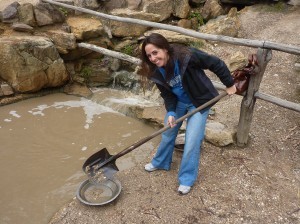 Adventures await in Melbourne. A short trip by train or two-hour journey by car finds you in Ballarat. Sovereign Hill, Ballarat’s interactive outdoor museum appeals to visitors of all ages. Pan for gold, dip a candle, visit the blacksmith and spend your day reliving the city’s gold rush period. There are underground tours, hands-on experiences and a gem museum that adds extra sparkle to the trip. Outdoor enthusiasts will enjoy Mt. Dandenong. Less than an hour’s car ride outside of the city sit quaint mountain towns, hiking trails, fresh mountain air and artistry unlike any other. You can hike up the Kokoda Track Memorial Walk’s thousand steps to happily earn sweet treats in one of the many adorable cafes. Areas of Sassafrass and Olinda are filled with cafes (my favourite: Miss Marple’s Tea Room) lolly shops, toy shops, tea shops and more that delight your fancy.
Adventures await in Melbourne. A short trip by train or two-hour journey by car finds you in Ballarat. Sovereign Hill, Ballarat’s interactive outdoor museum appeals to visitors of all ages. Pan for gold, dip a candle, visit the blacksmith and spend your day reliving the city’s gold rush period. There are underground tours, hands-on experiences and a gem museum that adds extra sparkle to the trip. Outdoor enthusiasts will enjoy Mt. Dandenong. Less than an hour’s car ride outside of the city sit quaint mountain towns, hiking trails, fresh mountain air and artistry unlike any other. You can hike up the Kokoda Track Memorial Walk’s thousand steps to happily earn sweet treats in one of the many adorable cafes. Areas of Sassafrass and Olinda are filled with cafes (my favourite: Miss Marple’s Tea Room) lolly shops, toy shops, tea shops and more that delight your fancy.
 Artists, dreamers, believers, creatives and naturalists can wile away the hours at the William Rickets Sanctuary. Meander through the trees to find incredible carvings and artistry all made by one man. Revering native Aboriginal culture and believing strongly in the lives, stories and message of its people, William Rickets creates unimaginable artwork through tree sculpting. Both the poetry and design exude the magic, trust, wonder, reverence and beauty that is nature.
Artists, dreamers, believers, creatives and naturalists can wile away the hours at the William Rickets Sanctuary. Meander through the trees to find incredible carvings and artistry all made by one man. Revering native Aboriginal culture and believing strongly in the lives, stories and message of its people, William Rickets creates unimaginable artwork through tree sculpting. Both the poetry and design exude the magic, trust, wonder, reverence and beauty that is nature.
Journey to the Seaside
Melbourne’s Yarra River flows through the center of the city. Festivals, fireworks and fun happen along the water daily. Searching for a greater view, that specific scent, picturesque coastline, sailboat sightings or just an expedition all your own-Melbourne has that, too. A quick ferry ride away lies the charming seaside town of Williamstown. With its laid back vibe, quaint boutiques, quirky cafes and ice cream shoppes, Williamstown offers a perfect retreat from the buzz of the city. Explorers for a day or a week can experience the rush of life alongside the Great Ocean Road. Deliriously daunting cliffside views halt drivers in their tracks, forcing a stop, look and photo session at each of its thousand twists and turns. Go for a day, stay for a night or ride all the way to Adelaide-no matter the distance, the Great Ocean Road doesn’t disappoint. Gorgeous beaches line the roadside as seaside towns invite you to taste their splendid fish and chips or take part in their endless outdoor activities.
If you’re visiting and missing the roar of the ocean, Melbourne’s beaches are for you. Whichever direction you choose to head, there are waves just waiting to wash over wiggling, happy sand-laden toes. Visit Portsea and Sorrento on the Mornington Peninsula to take in the main streets of the towns while hiking down to local beaches to watch surfers find the sweet spots on the many waves. Want a fun train trip and colourful backdrop to stunning white capped waves, hit Brighton for the day where the iconic Beach Boxes are just as much the draw as the sun and the sea. Looking to add a little wildlife adventure to your day on the sand? Take the two-hour drive to Phillip Island to experience the fish and chips, endless scenic views and the Little Penguin Parade. Channel your inner penguin as you wait patiently for some of the world’s cutest creatures to pop out of the water at dusk and waddle their way past your camera lens and back to their burrows for their evening slumber.
Nature, Wildlife, Wine and Cheese
 Whether you’re in it for the wine, cheese, or kangaroo cuddles, the Yarra Valley is for you. Filled with lush eye-catching scenery, wineries by the dozen and cafes galore, this bucolic area lies a short distance from the hustle and bustle of one of Australia’s busy cities. If you’re interested in getting up close and personal to native wildlife, spend a day at Healesville Sanctuary. This interactive nature sanctuary is home to heaps of Australian wildlife. Whether you fancy feeding a wallaby, chatting with a kangaroo, counting the quills of an echidna or just relishing time spent with the friendly animals; a day at Healesville will put a smile on the faces of guests both young and old.
Whether you’re in it for the wine, cheese, or kangaroo cuddles, the Yarra Valley is for you. Filled with lush eye-catching scenery, wineries by the dozen and cafes galore, this bucolic area lies a short distance from the hustle and bustle of one of Australia’s busy cities. If you’re interested in getting up close and personal to native wildlife, spend a day at Healesville Sanctuary. This interactive nature sanctuary is home to heaps of Australian wildlife. Whether you fancy feeding a wallaby, chatting with a kangaroo, counting the quills of an echidna or just relishing time spent with the friendly animals; a day at Healesville will put a smile on the faces of guests both young and old.
For more of Stacey’s musings visit her website.
Original article can be found here: Easy Day Trips from Melbourne, Australia
February 12, 2015
Vagabonding Field Report: Wandering the streets of Paris
Cost/day:
As far as European cities, Paris isn’t the cheapest, but there are some simple tricks and strategies that can keep your Paris budget to around $60 a day within the city. For instance, I stay in hostel dorms, walk whenever I can, and alternate between eating out and cooking my meals.

What’s the strangest thing you’ve seen lately?
I went to a French film in Paris. It was a very odd experience. I didn’t understand the plot and unfortunately, they had no English subtitles so I found myself guessing throughout the movie. In truth, French Cinema is very strange compared to what I am used to. Even the atmosphere of a theater in Paris has a strange feel to it.
[More.. Break]
Describe a typical day
Today I woke up with the number one goal of walking to the Eiffel Tower, a formidable feat from my hostel on Crimée Street. Now, I realize that you are probably asking, “Why walk?”. The answer is simple. There is no better way to get a feel for a city and culture than by walking it.
So I wake up early and begin my leisurely stroll through the quiet cobblestone streets and tiny alleyways. The scent of world-renowned fresh bread and doughy pastries fills the air, instantly sending hunger pains into my stomach.
I step into the first open cafe and order a frothy cappuccino and delicious chocolate filled croissant; a breakfast meant for savoring. Eventually, the urge to beat the massive crowds spurs my feet into action, and I start walking until I reach the river, Seine.
Following the river, I am soon greeted by one of my favorite sights in Paris: Notre Dame. This gothic cathedral is a marvel, towering over every building in the area. Every time I am in Paris, I happily get stuck at this wonderful monument.
Each time I visit, my mind travels back in time to centuries past and all the history that happened here. Although I’m eager to get to the Eiffel tower, there are two more stops I can’t pass up on the way.
The first is the Shakespeare and Company bookstore, where personal literary heroes of mine including legendary Ernest Hemingway and James Joyce would often gather to sip brandy and discuss life.
The next stop is the Louvre and the gorgeous gardens surrounding it. Every time I look at the Pyramide du Louvre, I imagine future travelers visiting this glass pyramid and standing in awe, much the same way I do today as I fly around the globe looking at historical sights such as the Collosuem.
The gardens surrounding the Louvre are filled with Greek statues and modern art.
It is a beautiful clash of the ancient with the modern and appeals to the history buff inside of me. I could stay here all day, but I know it is time to move on so I start on the last leg of my journey, an hour walk to the Eiffel Tower.
Although I don’t have any other major stops along the way, I do briefly pause to browse the wares in the stalls along the river.
Approaching the Eiffel Tower, I can’t help but be impressed once again by its size and beauty.
It is the middle of the afternoon now, and while I didn’t make it to the Eiffel tower as early as I planned, I still can’t resist the urge to wait in line to take the elevator to the top. You see, from the top of this beautiful metal wonder, you get an overwhelming view of this grand city.
Paris is a city that holds a lot of charm and romance even if you are traveling solo, and I can’t help but visit the city over and over again. It has become like meeting an old friend that I embrace with great fondness every time I visit.
Conversing with locals.
Most of the magic that happens while traveling is in the unexpected conversations. Some of the best use no or very little common language and is conducted simply by body motions. Personally, I like eating at hole-in-the-wall diners, shopping at local street stands, and getting off the tourist track. I soon discovered how important it was to know how to communicate without words.
The last interesting conversation I had with a local was in a small restaurant in France trying to ask directions.
The older gentleman didn’t speak any English and shamefully, I don’t speak any French. Thus, we had about a ten minute conversation that involved me trying to explain where I wanted to go and him drawing me a map covered with French writing.
Believe it or not, he was more than willing to help. He laughed a lot, made a few jokes, and wished me well all through body language.
I love communicating this way because it shows that language doesn’t have to be a barrier. Locals want you to enjoy their country and even though this man knew I did not understand his words, he found a way to communicate. I walked away smiling; humanity did not disappoint.
I cannot tell you how many friends I’ve made in countries all over the globe where I do not know a person’s name. I do not know if they are married, have kids, or what they do for a living; however, I do know their kindness and their character because they have helped me when I needed it the most without a second thought. Traveling shows you the goodness of people despite language barriers and culture differences.
What do you like about where you are? Dislike?
Paris isn’t about the sights. It is about the food, the people, and the wine. Things I like about Paris are strolling the streets, shopping at the stands, sitting in coffee houses, and kicking back with the locals.
One thing I hated at first, but now enjoy, is the rude waiters. Paris is known for its rude waiters, something I didn’t know at first and found rather confusing. Soon though, I realized that it is just part of the culture and now I just smile when I experience it.
What was your latest challenge?
This wasn’t my latest challenge but one worth mentioning since it involves Paris. In all honesty, the first time I visited Paris was horrible. I showed up on a late night bus in a bad part of town with no place to sleep and nowhere to go during one of the most chaotic times for the city. Luckily it all worked out, but the first few days where rough. Plus, it was my birthday and after the first night, I felt like I wanted to be anywhere but Paris.
It took me a while to feel out what the city was about. Of course, once I did, I fell in love.
What new lessons has Paris taught you?
Paris has taught me a few things. One being to always book accommodations ahead of time as it is a massive travel hub for the UK and Europe. Many hostels are booked out all year round. Travelers should book accommodations a least a month in advance or might risk taking a train to the airport just to get a safe night’s sleep.
Take my advice; I have done that on more than one occasion and it is an experience I don’t want to repeat.
Where next?
Next I am headed to my all time favorite country in the world, Italy. I am a history buff and what better place to visit than a country that was the center of the world for two thousand years.
Stephen is a long-term traveler and city wanderer You can check out more of his musing of life on the road at his website A Backpackers Tale, Facebook, and Pinterest.
Original article can be found here: Vagabonding Field Report: Wandering the streets of Paris
February 11, 2015
Ways travel enhances education
Families traveling the world with their children get asked a whole lot of questions. Topping the list are questions about their children’s education. It seems everyone wants to know what these traveling kids are learning, how, and with whom. And these questions don’t really stop as the kids get older. Ask any young adult taking a gap year abroad and they will inevitably tell you that one of the biggest fears expressed by those closest to them was a fear that they would “miss out” on a year of college or other form of higher education.
However, travel in itself is one of the best forms of “higher education”. Not only are practical life skills put into practice everyday on the road, but experiences had while traveling generally serve to enhance any education. Some of the deepest thoughts, biggest questions, and most divergent problem solving happens while journeying.
So, how exactly can travel be it’s own (or enhance) education?
Communication Skills- Learning a new language is the most obvious way this skill is developed. There is no down side to knowing a second language- even just the basics- in an increasingly global society. But consider all the other ways you need to communicate when traveling. Language barriers and cultural norms are just two major hurdles to navigate when communicating abroad. You need to have a pretty good grasp on body language in order to communicate effectively and without offense in a culture that isn’t your own. Hand gestures and charades become refined skills for use in challenging situations. Clarity and intentionality become increasingly important when communicating across language barriers. Knowing how to communicate effectively across language and cultural barriers is a serious benefit for anyone hoping to function in our current world.
Cultural Awareness- Trust me, there is a huge difference between being lectured on cultural sensitivity and developing an awareness of cultural norms through first hand experience. There is nothing quite like being the odd man out in a foreign culture to create a space within yourself to feel empathy for people who are often overlooked or treated poorly. Likewise, navigating the ins and outs of a foreign culture in person is far more informative than reading about it in a book. Being forced to adjust to unfamiliar cultural norms can be challenging but it also encourages the traveler to become increasingly aware of social cues, norms, and expectations. This all happens while making personal connections with the people you are learning from and about, making the development of awareness far more likely to be internalized. It’s an incredible synchronicity that offers lessons in navigating cultural differences more confidently.
Adaptability – Traveling, especially long term, offers no shortage of opportunities to adapt. From trains that don’t come to baggage that never arrives, when you have no “extra” time, space, or things- you adapt. Just getting out into the world, away from the creature comforts you have come to know and love, is a lesson in adaptability. What is the hottest temperature you can stand without air conditioning? What time can you pull yourself out of bed to catch that bus? What is the least amount of sleep you can run on? How many times can you eat the same dish before you scream? How an you communicate your needs to this host family without offending? The ability to operate outside of your comfort zone is something that most educators would say is a benefit to any student.
Self- Reflection- No education is complete without the ability to self-reflect. Why? Well, if you aren’t able to apply what you have learned to your own life, philosophies, and choices, have you really internalized the lesson? Sitting in a classroom, discussing oppression is one thing. Having the ability to reflect on your own words and actions and how they might be adding to the systemic oppression of certain people is a whole other ball of wax. Self-reflection is what separates the good students from the truly educated. In order to perfect the art of self-reflection, you need time and space. Travel provides plenty of that. Not only that, but sometimes getting outside of your home county provides just enough distance to contemplate your role in the world thus far and what it might look like moving forward.
Perspective- Sometimes, in order to gain perspective on your needs, goals, and actions, you need to get some distance. Even a seven year old, sitting on the beach in El Salvador, is aware enough to notice stark contrasts between how the world functions in a developing nation and a developed one. Learning about the developing world from a book is nice but actually seeing it brings it to life. Perspective often creates space for a student to “connect the dots” so that history and economic lessons are no longer just words on a page.
Awareness- It could be argued that this is the key ingredient missing from a lot of standard educations. Travel makes it impossible not to recognize that other people matter. It breaks down the barrier between “us” and “them”, even just little. As mentioned above, travel also creates space for intense self-reflection, which helps creates a deeper awareness of self. Awareness of your own needs and the need of others is something that isn’t focused on in the fact and results based education most students receive today. But an enhanced awareness of others and of yourself can lead to a more engaged student, one who understands the real-life ramifications of her lessons learned.
Problem Solving- This one almost goes without saying. Who in the world has ever traveled and not had to solve some problem that cropped up? Anyone? Hands on experience in problem solving is almost a given when you are traveling. Any kid who is on the road with their parents (or taking a gap year) is going to have an incredible abundance of opportunities for practicing and witnessing problem solving- sometimes extremely creative problem solving. The ability to think outside of the box is something that is often not practiced enough in the era of high stakes testing. Adding this skill to any students’ tool kit is going to go a long way.
Initiative- This one is something not everyone recognizes right away as a benefit of travel. What happens to a kid when they see their parents take the plunge into an alternative lifestyle, one that bucks the system and involves long- term travel? What happens to the teenager who, against all advice, takes an entire year (or more) to put college off and do exactly what their gut tells them is imperative to their development? These kids become go-getters. They learn that taking initiative is not a bad thing. They learn to go after what they want and blaze their own trails. As far as education goes, the ability to take initiative is incredibly beneficial! It means knowing when to ask questions, where to look for resources, and not waiting for others to tell you how to do it. Initiative creates life-long learners that continue to educate themselves long after the last school bell.
Time- Time isn’t a skill but it is a gift that all students should have access to. Time to explore, think, question, interact, and just be. In this world that places a high demand on the constant pursuit of “success”, time is often sorely lacking. As a result, lots of students have forgotten how to just be without doing work (or actively trying to avoid it, as the case may be). Stepping outside of the norm and purposely carving time for all of those things leads to a richer, fuller experience of life. That richer, fuller experience in turn leads to more content people who actually enjoy learning and truly internalize the lessons that come their way. Every teacher looks for a student who is eager to learn. Give a student the gift of time and even some of the most reluctant learners will start to resemble that ideal student.
While every traveling family or student will find their own ways of addressing education on the road, there is no need to be worried about anyone “missing out” on education while traveling. These are just some of the ways travel supports and enhances any type of education- there are many more! Can you add to the list?
Original article can be found here: Ways travel enhances education
Mistake-fare rule of thumb: DO NOT CALL
If any of you have become regular readers of “Business Insider”, you might have have read about an incredible $74 round-trip price from Newark to London in business class. In their article on February 11 at 8:39 am they had the following things to say about this “deal.”
This might be the deal of the year.
United Airlines is offering travelers first-class tickets from London to Newark, roundtrip, for 487 Danish krone. At 6.58 krone per dollar, that comes out to $74. Newark is just minutes outside of New York City. DansDeals found this first.
(The original article can be found here: United Airlines First Class Tickets )
I have a few problems with this. Firstly, the author is referring to this as a deal that “United airlines is offering.” My first reaction was that such a phrase did not seem a very genuine description of what was most likely going on. At least in my opinion it implies that United offered these rates intentionally. But…I’ll get to that later.
I don’t see these fares as deals offered by anyone. I see them as glitches that a person could potentially take advantage of, but that the person is not entitled to.
In my niche, we call these glitches “mistake-fares.” They are fares that the airline does not intend to offer, but because of a glitch in the pricing process, the price gets listed and programmed as much lower than intended. Often times it’s a coding issue of some kind, leaving off a fuel surcharge for instance.
No surprise, just a few hours later Business Insider UK reported that the “deal” was dead.
That is indeed the norm for such “deals,” or rather, mistakes. The reality is, these prices only last until the airline or aggregator realizes the issue and fixes it. And the more people are chatting about the deals online or in widely-read media outlets such as Business Insider, and the more people who are purchasing the fare, the more quickly the airline or aggregator will catch on to the issue.
Now, I have no problem with a great deal getting exposure so that lots of people can take advantage of it, (if the airline ultimately decides to honor the rate). The risk however, is that someone may misunderstand the glitch as an intentional deal and may try to call the airline asking about it.
There are all sorts of reasons people call when they’re booking a trip. Perhaps a person can’t find availability for the time they’re interested in or perhaps they want to make sure the rate will be honored.
But the key thing to realize with these mistake fares is that they are (except perhaps in a few suspicious cases that look a bit like publicity stunts) almost certainly unintentional. And therefore not a single person is entitled to anything more than a refund. Thus, the airline in no way needs to help you understand or book this accidental fare.
I can’t be more clear about this: if you are booking a mistake-fare like this one, do not call the airline to ask about it unless you genuinely wish to end the deal. If you feel a moral obligation to let the airline know about the mistake-rate so that they can end it, then I am certainly not going to be the person to tell you not to do that. Go for it. But that is the only effect calling will have.
You can consider this my little “mistake-fare” PSA: if you call the airline about its mistake-fare, they will shut the rate down.
Now, earlier I referenced a bit of distaste for how Business Insider referred to the fare as something United was offering. But since my initial read-through of BI’s article, I came across another article by View From The Wing that sheds light on why an author might not describe such a deal as a mistake-fare.
According to VFTW’s article, the DOT is possibly reconsidering its current stance holding airlines accountable t0 honor such fares. Apparently the DOT is seeking a way to defend the consumers who honestly think the low rate is a real rate while not letting other consumers (who see through it as a mistake) get away with knowingly taking advantage of the mistaken rate. While I can’t begin to fathom what the DOT will end up doing about this concern, the distinction between consumers who are naive of a mistake and those who are suspicious of it seems to provide an incentive for journalists and bloggers to remain vague about low rates, publishing no assumptions as to whether or not the rate is a mistake.
Whether or not Business Insider knows that this rate was most likely a mistake, I have no idea. But when you see a rate that’s too good to be true, know that it probably is. And therefore, don’t call the airline about it and, if you want to be extra cautious, don’t publish anything online about it either!
Original article can be found here: Mistake-fare rule of thumb: DO NOT CALL
February 10, 2015
Vagabonding Case Study: Marysia Maciocha
Age: 30
Hometown: I come from an average size city in Northern Poland. Name won’t ring a bell to anybody.
Quote: “Traveling is like flirting with life. It’s like saying, ‘I would stay and love you, but I have to go; this is my station.” – Lisa St Aubin de Teran
How did you find out about Vagabonding, and how did you find it useful before and during the trip? As far as I remember some friend of mine shared one of the Vagabonding posts on Twitter and that is how I have learned about this great site. I read mainly for inspiration and to learn about other approaches and personal stories of other travelers.
How long were you on the road?
I’m on the road for more than 6 years but I have been coming back home every now and than. Family and friends are very important to me. I always make them my priority, even if it means coming back for a wedding from my beloved Iran or sticking around Europe for few months due to previous arrangements.
Where did you go?
Almost all continents, but my favorite destinations are Africa, Central Asia and Middle East. Places like Iran, Benin, Oman, Azerbaijan and Kazakhstan. My biggest dreams, which are still yet to come, are Pakistan and Madagascar!
What was your job or source of travel funding for this journey?
I’m educated to be a lawyer and worked in my profession before quitting to travel the world. I have been lucky enough to invest my money smartly and being able to found my travels out of annual dividends. It is not a fortune, but as I do not have any obligations like house payments, car insurance etc… I can spend everything for my travels!
Did you work or volunteer on the road?
3 years ago I have started my travel blog and so far it was my only work. I have volunteered on several occasions, unfortunately only for a week here and a week there. I would love to settle somewhere for longer and work as a volunteer, preferably in some micro projects foundation and awareness growing campaigns in Africa.
Of all the places you visited, which was your favorite?
Without a doubt Iran!
Was there a place that was your least favorite, or most disappointing, or most challenging?
If I have to point fingers I would say Egypt. It was my least favourite place due to terrible attitude of Egyptian men to Western women.
Which travel gear proved most useful? Least useful?
I’m not sure if it can be considered a travel gear but I must say a scarf! It takes very little place in my bag and it saved my life more than few times. It sparkle your style, it can protect you from sun, rain, wind and cold. It is very useful in religious countries when you have to cover to visit mosques, churches and synagogues. I even clean my camera lens with it, I know it is not very ‘professional photographer attitude’ but what can you do when your lens is in need of some cleaning after few hours on the bumpy dirt road.
What are the rewards of the vagabonding lifestyle?
Total immersion in other cultures, cuisines and landscapes! Getting to see and experiences what others only read about in National Geographic. Learning, observing, gaining a bigger understanding and appreciation for a world at large and little things back at home.
What are the challenges and sacrifices of the vagabonding lifestyle?
Family and friends. They always take the biggest hit. You are almost never present in the most important moments of their lives. I myself try to make an effort (come back for weddings, special occasions and events) but it is not always possible.
What lessons did you learn on the road?
I have learned not to put anything till tomorrow and to live my life to the fullest. To enjoy little things and to have fun.
How did your personal definition of “vagabonding” develop over the course of the trip?
Actually definition of ‘vagabonding’ never changed for me. For me it was always about wondering, observing and learning about different cultures.
If there were one thing you could have told yourself before the trip, what would it be? Always indulge in your craziness Marysia.
Any advice or tips for someone hoping to embark on a similar adventure?
Pack your smile, common sense and go! Use your time well, it is not a rehearsal, there is no second chance.
When and where do you think you’ll take your next long-term journey?
I hope it will be first half of the year 2015 I would love to go and travel through all countries of Central America. Fingers crossed!
Read more about Marysia on her blog, My Travel Affairs , or follow her on Facebook and Twitter.
Website: My Travel Affairs
Twitter: @MyTravelAffairs
Are you a Vagabonding reader planning, in the middle of, or returning from a journey? Would you like your travel blog or website to be featured on Vagabonding Case Studies? If so, drop us a line at casestudies@vagabonding.net and tell us a little about yourself.
Original article can be found here: Vagabonding Case Study: Marysia Maciocha
February 8, 2015
Being “spiritual” is a way of being exuberant and alive
“The literature of mystical or spiritual experience continually reminds us that the origin of the word ‘spirit’ is closer to that of a high-spirited child, or a spirited horse, than it is to any kind of anaemic piety. First and foremost, ‘spiritual’ means bursting with exuberant life. There is also that strong sense of belonging: of being at home in a benign universe that is both loving and lovable. Wherever I am feels like ‘my place'; whoever I am with are ‘my people’. When this is the case, attitudes of suspicion or competition are replaced with what appears to be an unforced inclination towards kindliness and care.”
–Guy Claxton, “Get Your Kicks,” Aeon, November 8, 2013
Original article can be found here: Being “spiritual” is a way of being exuberant and alive
Rolf Potts's Blog
- Rolf Potts's profile
- 323 followers


